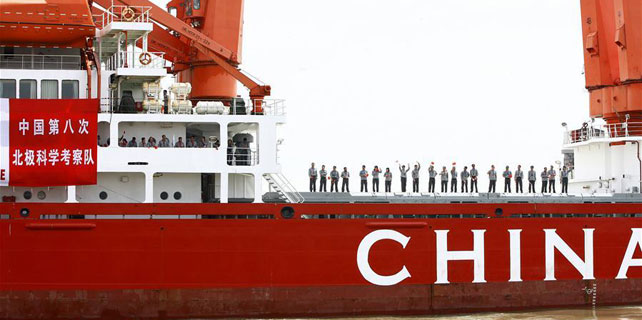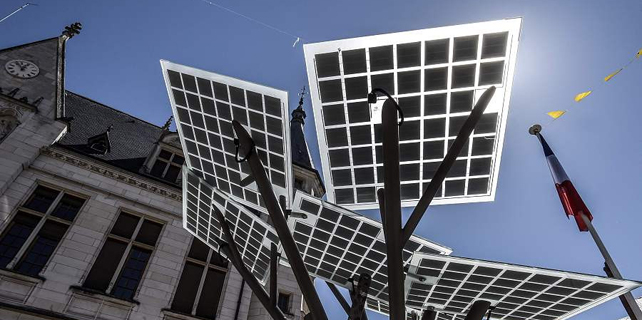Hidden underground network tackling flood threat
Ever wonder why Tokyo does not flood?
Next time when you are walking around the Japanese capital, stop for a minute to consider this: Just 50 meters below the ground is a labyrinth of tunnels, cathedral-like water tanks and massive pumps that can remove 200 tons of floodwater every second.
It has been described as the biggest underground man-made drainage system in the world.
With around 30 percent of Tokyo's population living below sea level, mostly along Tokyo Bay or the many rivers that feed into it, the metropolis has had a long history of disastrous flooding.
As the capital city grew and Japan prospered, protecting the world's largest metropolitan economy and its inhabitants — over 13 million in Tokyo today and more than 36 million in the greater metropolitan area — became a national priority.
The simplest solution would have been to build a reservoir. But the question facing urban planners was: How do you build a reservoir in a city twice as dense as New York? The answer: Build it underground.
The results were the Metropolitan Area Outer Underground Discharge Channel, also known as G-Cans, and more recently, the Furukawa Underground Regulating Reservoir.
Completed in 2006, the G-Cans gathers the overflowing floodwater from rivers in Tokyo, such as Oochi Kotone, Kuramatsu, Nagakawa and Arakawa, and drains it into the Edo River.
It is the world's largest underground floodwater-diversion system, said Koichiro Omoto, a water specialist with the Asian Development Bank Institute in Tokyo.
Costing around $3 billion, the G-Cans connects five of Tokyo's rivers via vertical drain shafts, each big enough to hold the Statue of Liberty with room to spare.
"The shafts are connected by a 6.3 kilometer underground tunnel, through which excess water from heavy rain travels and is collected in a subterranean reservoir," Omoto told China Daily.
Once the storm subsides, the water in the reservoir gets pumped into the Edo River at a point where it has the capacity to carry the excess water to the ocean without further flooding.
The water is released at a combined rate of 200 cubic meters per second — the equivalent of completely draining one Olympic-sized swimming pool every 12.5 seconds. The pumps are driven by four turbines powered by Boeing 737-sized jet engines.
 |
|
People walk with their umbrellas during rainy weather in Tokyo. In recent decades, the intensity and frequency of rainstorms in the Japanese capital has increased dramatically, which could put pressure on the city's drainage system. AFP |
And when it is not filled with water, the reservoir becomes a popular tourist attraction.
Omoto, citing government figures, said the project has likely saved around 48 billion yen ($430 million) in property damage alone since it became fully operational.
In recent decades, the intensity and frequency of rainstorms in Tokyo has increased dramatically, according to the government's information agency.
Tokyo's annual rainfall averages around 1,500 millimeters which is not unusual. Singapore and Manila, by comparison, have over 2,000 millimeters of rainfall a year.
In recent years, localized downpours — dubbed "guerrilla rainstorms" have also become a problem, taxing the existing drainage systems and forcing authorities to expand the city's water diversion network.
The Furukawa Underground Regulating Reservoir is the latest addition to Tokyo's network of underground water-storage facilities.
The Furukawa River winds through Tokyo's Shibuya and Minato wards, which are some of the city's most densely packed neighborhoods, according to the government.
Due to space constraints, the reservoir has been built 15.24 meters directly underneath the course of the river, which often makes acute turns, complicating the project's construction.
The 3.3 km long, 7.5 meter diameter drainage tunnel can hold 135 million liters of storm water, which is equal to the volume of 54 Olympicsized swimming pools.
Systems like the Metropolitan Area Outer Underground Discharge Channel and the Furukawa Underground Regulating Reservoir have dramatically reduced the flooding and damage caused by heavy rainstorms.
"It is also largely thanks to these kinds of underground and out-of-sight systems protecting Tokyo that it is uncommon to see pools of standing water on the city's streets, even after the heaviest of rains," the government said.
"As Tokyo continues to adapt to changing weather patterns, it is likely that these systems will continue to play a key role in protecting the city for many years to come."
But there are some who do not share that optimism. With the effects of global warming becoming increasingly obvious, there is no degree of certainty as to the severity of storms and rainfall.
Nobuyuki Tsuchiya, a civil engineering expert and author of the 2014 book Shuto Suibotsu (The Capital Submerged), has his doubts.
In an interview with The Japan Times, he said weather conditions previously considered very rare are becoming increasingly prevalent due to the growing impact of global warming. He noted that weather and rainfall patterns are changing.
Akira Kawamura, a professor of engineering at Tokyo Metropolitan University, agreed. In the same interview, he said: "Should the banks of the Arakawa River (which flows from Saitama prefecture and through Tokyo to Tokyo Bay) break, the damage would be so extensive that it could annihilate the entire capital, with the below-sea-level areas in eastern Tokyo, including Koto and Edogawa wards, likely to be hit the hardest."
The World Bank noted that extreme weather conditions are among the most devastating effects of global warming. These include powerful typhoons, monsoon rains, hurricanes and tropical cyclones that wreak havoc on cities and other lowlying areas.
It said floods are considered the world's "most frequent destructive natural disaster and the cost of rehabilitation is taking a toll on most of the world's economies".
With the growing frequency and intensity of abnormal weather conditions across the region, Tokyo is held up as a model of what can be done to protect urban areas from flooding. However, such preventive measures come with no guarantees.
















